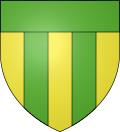|
Aigues-Vives, Ariège
Aigues-Vives (French pronunciation: [ɛɡ viv] ⓘ; Occitan: Aigasvivas) is a commune in the Ariège department in the Occitanie region of southwestern France. The inhabitants of the commune are known as Aigues-Vivesiens or Aigues-Vivesiennes.[3][4] GeographyLocationAigues-Vives is located both in the Pays d'Olmes and the Canton of Mirepoix on the D625 main road (formerly Route nationale N625) which runs from Saint-Quentin-la-Tour in the north through the heart of the commune and the town to Laroque-d'Olmes in the south. It is about 90 km in a direct line south by south west of Narbonne. Augues-Vives can also be accessed from the east on Highway D28 from Léran. Apart from the Aigues-Vives town there is one other residential area to the north of the town called Le Kartare. The commune is forested to the west and the east with the centre of the commune farmland (apart from the town).[5] Neighboring communes and villagesHydrographyThe Countirou stream, which has its source in the nearby village of Tabre, passes through the commune of Aigues-Vives, along the D625 road, and comes to an end at Hers-Vif near Mirepoix. A number of streams traverse the commune and flow into Coutirou including the: Fontaine de Toustou, the Couxou, the Ribalerie, and the Saint-Paul).[6] Lake Montbel is located three kilometres south-east of the commune and is visible from the hills above Aigues-Vives. Geology and terrainThe village is located in an area formed during the Tertiary period with a soil which is a mix of conglomerate and sandstone,[7] on strata called the "conglomerates of Palassou" located on the North Pyrenees faultline.[8] Aigues-Vives is surrounded by several hills, the highest being 630m above sea level, on the western edge of the commune. The village itself is 420m high on average with the lowest point being 391m.[6] Seismicity and disastersAccording to decree No. 2010-1255 of 22 October 2010 on the delimitation of the seismicity of the French territory, Aigues-Vives is exposed to a risk level of 3 (moderate).[9] Other risks facing Aigues-Vives are forest fires, industrial hazards, and risks due to transport of dangerous goods.[10] Past disasters include the November 1982 storm, flooding and mudslides in January 1992 and mudslides in November–December 1996.[11] ToponymyAigues-Vives or in Occitan Aigas Vivas meaning "whitewater" takes its name from springs in the surrounding hills.[12][13] There were also these old forms: Aygas vivas (1300) Aquisvivis (1377), and Aiguesvives (1801).[4] HistoryThe first written mention of Aigues-Vives dates to 1301.[13] The village was under the control of Mirepoix, ten miles to the north, until 1329, when Gaston de Lévis-Léran appropriated the castle and the surrounding lands. The village remained in the possession of the Lévis-Léran family until the Revolution.[4] The main industries in the 20th century were the making of "horn combs"[14] and textiles, as is the case for much of the Pays d'Olmes.[4] Heraldry
Policy and administration Municipal administrationBased on the number of inhabitants (more than 100, less than 499), the town has a council of 11 members.[15] List of mayors[16]
Population and societyPopulation
Pyramid of agesThe population of the town is relatively young. Percentage Distribution of Age Groups in Aigues-Vives and Ariege Department in 2017
EducationAigues-Vives has a kindergarten and primary school, with 68 students (for the academic year 2010–2011).[19] SportsSeveral sports facilities exist in Aigues-Vives: a football club, a gymnasium, a tai chi group, a bicycle club, and a leisure centre which has a go-karting track and a mini-golf area.[13] HealthThere is no pharmacy or doctor in Aigues-Vives with the closest being at Laroque-d'Olmes about 3 kilometres away. The nearest hospital is in Lavelanet seven kilometres away. EconomyIncomes of the population and taxationIn 2017, the median net household income was €19,290.[20] Employment, business and tradeThe rate of unemployment in 2017 was 15.5% and slightly higher among women than men.[20] There are several companies in the building trades, particularly masonry and housepainting in Aigues-Vives and there is also a textile company and a website design business. There is an Asian caterer, a camping ground, and a Karting Club.[21] Agriculture and livestock is another sector of activity in Aigues-Vives: wheat, forage grass, and vines are grown, while cattle and sheep are also raised. The nearby forests are exploited and are rich in mushrooms.[22] Wind farm projectA project to create a wind farm on the ridges of the Serre du Tut was launched and then abandoned[23] due to strong opposition, especially from the Association for the Preservation and Tourism and the Sites in the Pyrénées Mountains.[24] Local culture and heritageSites and monuments

Notable people
See alsoBibliography
References
External links
Wikimedia Commons has media related to Aigues-Vives (Ariège). |
|||||||||||||||||||||||||||||||||||||||||||||||||||||||||||||||||||||||||||||||||||||||||||||||||||||||||||||||||||||||||||||||||||||||||||||













